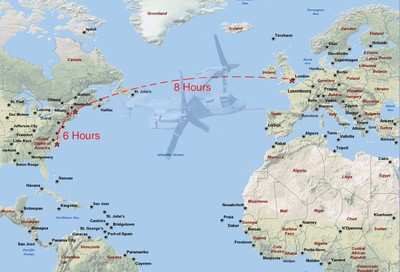 Two MV-22B “Ospreys,”
belonging to Marine Tiltrotor Test and Evaluation Squadron 22, made
history last month by completing the first-ever Tiltrotor Vertical
Assault Aircraft trans-Atlantic flights Saturday, July 29. The
“Ospreys” successfully flew from North Carolina to
England and back.
Two MV-22B “Ospreys,”
belonging to Marine Tiltrotor Test and Evaluation Squadron 22, made
history last month by completing the first-ever Tiltrotor Vertical
Assault Aircraft trans-Atlantic flights Saturday, July 29. The
“Ospreys” successfully flew from North Carolina to
England and back.
“The MV-22's ability to make two trans-Atlantic flights
within a three week period, and fly every day in Great Britain
during that time period confirms its reliability,” said Col.
Glenn M. Walters, VMX-22 commanding officer.
“The aircraft and aircrew performed above my expectations
in accomplishing the most arduous portion of a self-deployment.
This was the final event that demonstrated the full range of unique
capabilities this aircraft will provide to our war fighters in the
near future."
The flight covered more than 4,000 miles, much of it over the
North Atlantic, in challenging weather conditions. Both aircraft
were conducting a self-deployment rehearsal in preparation for the
“Osprey’s” operational deployment scheduled for
next year. Over 40 Marines participated in the exercise, including
pilots, aircrew and ground support personnel.
One of the Marines to pilot the trip was Maj. David L. Lane, an
“Osprey” pilot since early 2004 and a Paris, Ark.,
native. Lane said it felt fantastic to pilot the mission and become
a small part of history.

“Being a part of this mission was special and it felt
great to have the commanding officer’s confidence placed in
me to sign for the other aircraft,” said Lane.
An additional purpose of the rehearsal was for the Marine Corps
to develop tactics, techniques and procedures for long-range,
over-water movements of MV-22s. The “Ospreys” also
participated in the Royal International Air Tattoo in Fairford and
the Air Show at Farnborough, U.K.

While in England, the “Ospreys” flew a total of 17
flight events, all of which were executed on time. The
“Osprey” was one of a handful of aircraft at
Farnborough to have made all scheduled flight windows. These
flights included distinguished visitor and media orientation
flights involving short take-offs, tactical approaches to landing
zones, hovering and a “jump” take-off. Additionally, it
is estimated that 100,000 people viewed the aircraft on static
display.
“The spectators in England were excited to see the
‘Osprey’ fly, and the flights were moved from one of
the later slots in the air show to the main event,” said
Lane.
The exercise began July 8 when three MV-22Bs from VMX-22 and
three KC-130J “Hercules” aircraft from Marine Aerial
Refueler Transport Squadron 252, based at Marine Corps Air Station
Cherry Point, N.C., left the U.S. for Farnborough. After a stop in
Goose Bay, Newfoundland, two MV-22Bs and two KC-130Js continued on
to the U.K., while the other aircraft returned to North
Carolina.

On July 25, all aircraft left the U.K. to redeploy back to North
Carolina. All aircraft and crew safely returned home July 29.
This achievement helped to illustrate improved vertical lift
capability for such concepts as Sea Basing and Distributed
Operations, and greatly expands the reach and flexibility of Joint
forces. VMX-22 and VMGR-252 also validated the
“Osprey’s” long-range fuel system capability with
the goal of supporting future “Osprey” deployments.
During VMX-22’s change-of-command ceremony, Lt. Gen. John
Castellaw, deputy commandant of Marine Corps aviation, remarked on
the success of the historic trans-Atlantic flight and how this
brings the “Osprey” one giant step towards deployment
sometime next year.

“This was a rehearsal to demonstrate the
‘Osprey’s’ capabilities and to learn lessons so
when we do it again, for instance with (Marine Medium Tiltrotor
Squadron-263) when it deploys next year, we’ll have already
learned the basis to complete a similar flight,” said
Castellaw. “The leadership of the Marine Corps and those that
have been involved with the aircraft has had confidence that it
could complete a mission like this all along.”
 ANN's Daily Aero-Linx (04.13.24)
ANN's Daily Aero-Linx (04.13.24) ANN's Daily Aero-Term (04.13.24): Beyond Visual Line Of Sight (BVLOS)
ANN's Daily Aero-Term (04.13.24): Beyond Visual Line Of Sight (BVLOS) Airborne 04.09.24: SnF24!, Piper-DeltaHawk!, Fisher Update, Junkers
Airborne 04.09.24: SnF24!, Piper-DeltaHawk!, Fisher Update, Junkers Aero-News: Quote of the Day (04.14.24)
Aero-News: Quote of the Day (04.14.24) ANN's Daily Aero-Term (04.14.24): Maximum Authorized Altitude
ANN's Daily Aero-Term (04.14.24): Maximum Authorized Altitude







